5α-Reductase deficiency
5α-Reductase deficiency is an autosomal recessive intersex condition caused by a mutation of the 5α-reductase type II gene.[1]
| 5α-Reductase deficiency | |
|---|---|
| Other names | %-ARD |
 | |
| 5α-Reductase produces dihydrotestosterone | |
| Specialty | Medical genetics |
Signs and symptoms
Individuals with 5-ARD are born with male gonads, including testicles and Wolffian structures. They can have normal male external genitalia, ambiguous genitalia, or normal female genitalia, but usually tend towards a female appearance.
The development of the genital tubercle tissue (which by week 9 of a fetus' gestation becomes either a clitoris or a penis) tends towards a size qualifying it as an ambiguous macroclitoris/micropenis (large clitoris/small penis), and the urethra may attach to the phallus.
If the condition has not already been diagnosed, it usually becomes apparent at puberty around age twelve with primary amenorrhoea and virilization. This may include descending of the testes, hirsutism (facial/body hair considered normal in males – not to be confused with hypertrichosis), deepening of the voice, and enlargement of the clitoris into what would then be classed as a penis.
In adulthood, individuals do not experience male-pattern baldness.[1] As dihydrotestosterone (DHT) is a far more potent androgen than testosterone alone, virilization in those lacking DHT may be absent or reduced compared to males with functional 5-AR. It is hypothesized that rising testosterone levels at the start of puberty are able to generate sufficient levels of DHT either by the action of 5α-reductase type I (active in the adult liver, non-genital skin and some brain areas) or through the expression of low levels of 5α-reductase type II in the testes.
5-ARD is associated with an increased risk of cryptorchidism and testicular cancer.
Fertility
Since the gonad tissue develops into testes rather than ovaries, they are thus unable to create ova but may be able to create sperm. Male fertility can still be possible if viable sperm is present in the testes and is able to be extracted. In general, individuals with 5-ARD are capable of producing viable sperm.
Although the external genitalia can sometimes be completely female, the vagina consists of only the lower two-thirds of a normal vagina, creating a blind-ending vaginal pouch. Because of normal action of Müllerian inhibiting factor produced by the testes in utero, individuals with 5-ARD lack a uterus and Fallopian tubes. Thus, they would not physically be able to carry a pregnancy in any event. Even with treatments such as surrogate motherhood, female infertility is caused by the lack of any ova to implant in a surrogate mother.
In individuals with an ambiguous genital resulting in a macroclitoris/micropenis, the genital may be capable of ejaculations as well as erections, but may be of insufficient size for penetrative sexual intercourse.
Fertility is further compromised by the underdevelopment of seminal vesicles and prostate.
Cause
The condition affects only those with a Y-chromosome because DHT has no known role in development of XX fetuses.[2]
Mechanism
5α-Reductase is an enzyme that converts testosterone to 5α-dihydrotestosterone (DHT) in peripheral tissues. These enzymes also participate in the creation of such neurosteroids as allopregnanolone and THDOC, convert progesterone into dihydroprogesterone (DHP), and convert deoxycorticosterone (DOC) into dihydrodeoxycorticosterone (DHDOC). 5-ARD is biochemically characterized by low to low-normal levels of testosterone and decreased levels of DHT, creating a higher testosterone/DHT ratio.

DHT is a potent androgen, and is necessary for the development of male external genitalia in utero.
Diagnosis
Epidemiology
The condition is extremely rare, with areas of greater incidence known in regions of the Dominican Republic, Papua New Guinea, and Turkey.
The cases of the condition reported in the Dominican Republic are of greatest interest due to its prevalence in the small remote village of Las Salinas, where 12 out of 13 families had one or more male family members that carried the genetic mutation, though not all the carriers of the mutation were affected. The overall incidence for the village was 1 in every 90 males were affected carriers, the remainder of the village genetic males were either non-carriers or non-affected carriers.[3]
It is thought that either a founder effect or a bottleneck effect (the villagers are interrelated and may have inherited the mutation from the same individual), in conjunction with a lack of geneflow (genes from outsiders) in the isolated geographic location of Las Salinas allowed the mutation to become amplified in the village. In the Dominican Republic, the colloquial Spanish term for a person with the condition is güevedoce, a contraction in the local dialect of the phrase "huevos a los doce", meaning "eggs at twelve".[4] Huevo or güevo literally means egg, but is also slang for testicle, so the meaning is "testicles at age twelve".
It has been reported that in the cases seen in the Dominican Republic, locals celebrate when a child they previously believed to be a "girl" naturally transform into his male body upon reaching puberty and socially assumes his male gender role (in most cases, the gender identity had always been male even when the child was still socially a female).[5] In the cases in Papua New Guinea, it has been said that the "girl" is shunned when he begins his natural transformation into a male body and socially assumes a male gender role.[6]
Society and culture
Sport
In April 2014, the BMJ reported that four elite women athletes with 5-ARD were subjected to sterilization and "partial clitoridectomies" in order to compete in sport. The authors noted that "partial clitoridectomy" was "not medically indicated, does not relate to real or perceived athletic “advantage,"" relating to elevated androgen levels. The athletes were all from developing countries where lifetime access to hormone replacement may prove elusive.[7] Intersex advocates regard this intervention as "a clearly coercive process".[8]
Popular culture
In the Nip/Tuck season three episode "Quentin Costa", it is revealed that Quentin Costa had 5-ARD.
Jeffrey Eugenides' Pulitzer Prize-winning 2002 novel Middlesex is about a young man with 5-ARD. The character was originally born Calliope and raised as a girl, but upon realizing his genetic sex, he transitions into Cal.
See also
- Intersex
- Disorders of sexual development, pseudohermaphroditism, and ambiguous genitalia
- Inborn errors of steroid metabolism
- 5α-Reductase (I, II)
- Androgen (testosterone and dihydrotestosterone)
References
- "5-alpha reductase deficiency". GPnotebook.
- eMedicine article on 5-ARD
- Imperato-McGinley, Julianne; Guerrero, Luis; Gautier, Teofilo; Peterson, Ralph Edward (December 1974). "Steroid 5alpha-reductase deficiency in man: an inherited form of male pseudohermaphroditism". Science. 186 (4170): 1213–1215. Bibcode:1974Sci...186.1213I. doi:10.1126/science.186.4170.1213. PMID 4432067.
- AlMomento.net. "BARAHONA: Enfermedad genética hace que niños RD nazcan sin pene". AlMomento.net (in Spanish). Retrieved 2017-03-08.
- Mosley, Michael (2015-09-20). "The extraordinary case of the Guevedoces". BBC News. BBC News. Retrieved 23 September 2015.
- Imperato-McGinley J, Miller M, Wilson JD, Peterson RE, Shackleton C, Gajdusek DC (Apr 1991). "A cluster of male pseudohermaphrodites with 5 alpha-reductase deficiency in Papua New Guinea". Clin Endocrinol. 34 (4): 293–8. doi:10.1111/j.1365-2265.1991.tb03769.x. PMID 1831738.
- Rebecca Jordan-Young; Peter Sonksen; Katrina Karkazis (2014). "Sex, health, and athletes". BMJ. 348: g2926. doi:10.1136/bmj.g2926. PMID 24776640.
- "UN Human Rights Council: resolution, statement and side event, "The time has come"". Organisation Intersex International Australia. 2014-09-11. Retrieved 28 September 2014.
External links
| Classification | |
|---|---|
| External resources |